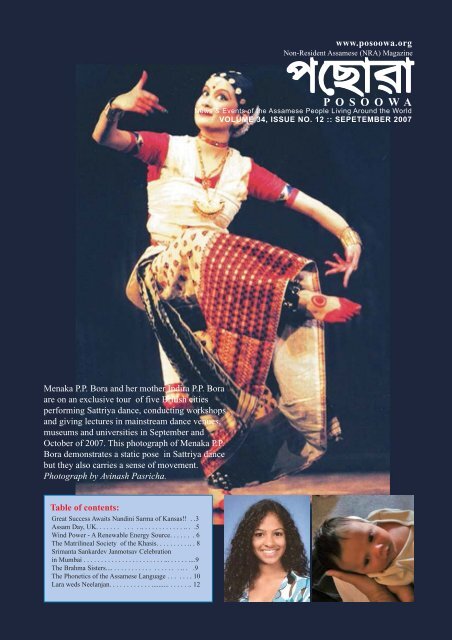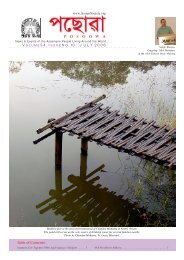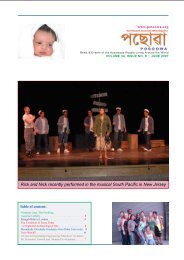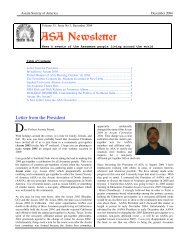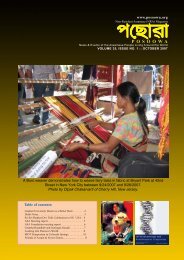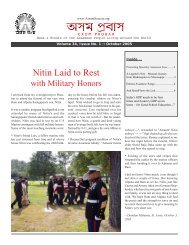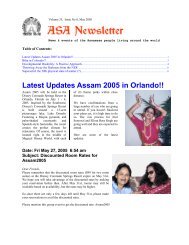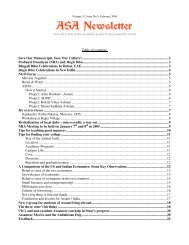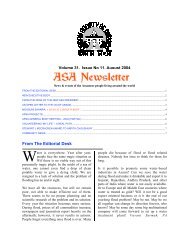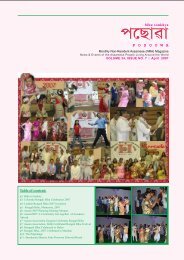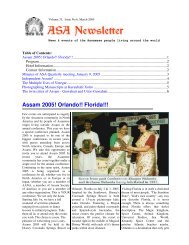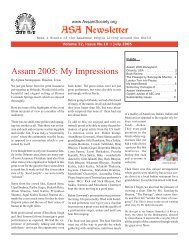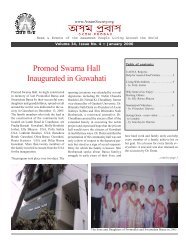You also want an ePaper? Increase the reach of your titles
YUMPU automatically turns print PDFs into web optimized ePapers that Google loves.
Nitin SarangapaniSeptember 25, 1981 - September 25, 2005Remembering Courage, Strength,Patriotism and Eternal YouthNitin Bezbaruah Sarangapani Memorial (NBSM) Fundwww.nitinfund.org
Great Success Awaits Nandini Sarma of KansasGreat Success AwaitsNandini Sarma of Kansas!!Nandini Sarma, a senior high school studentat the Shawnee Mission East High School,Kansas has recently received several awardsand wide recognition for her outstanding researchwork in biomedical sciences. Sinceher freshman year in high school, Nandinihas been conducting research to find solutionsto common health related problems suchas food-borne illnesses, cancer and viral infections.Her research on natural food preservativesrevealed that garlic (Allium sativum) caneffectively replace the harmful syntheticchemical preservatives from the food chain(meat and eggs), thus providing a healthfriendly, easily available and cost effectivenatural alternative to prevent food-borne illnessescaused by consumption of Salmonellaand E. coli contaminated meat and eggs.For cancer research, Nandini studied the effectof a selected virus infection on Herpesvirusinduced tumor development in-vivo andits affinity to kill transformed cells in-vitro.Although, from the preliminary studies shecame out with interesting findings and encouragingresults, further work is in progressbefore coming to a final conclusion.Recently, Nandini started working onpathobiology of Herpes simplex virus underthe mentorship of Prof. G. S. Read, one ofthe world’s most renowned scientists in Herpessimplex Virus research. Using RNAi, realtime RT-PCR and other molecular biologytechniques, she found that certain eukaryoticcellular translation initiation factors are requiredfor the virus to initiate infection andcause mRNA degradation, eventually leadingto cellular death. Her research findingswere presented at the 32nd InternationalHerpesvirus Workshop and a research paperis being prepared for publishing in the “Journalof Virology”.Her research on natural food preservatives,cancer and pathobiology of Herpes SimplexVirus infection brought her several awardsand recognition from the scientific communityat the national as well as internationallevel. She is the recipient of the Greater KansasCity Science and Engineering Fair(GKCSEF) 1st place grand award consistingof plaques, trophies, cash and certificates forthree years in a row for outstanding achievementin biomedical research and selected forall expense paid trips to present her researchfindings at the 2005, 2006 and 2007 Intel InternationalScience and Engineering Fair(Intel ISEF). At the Intel ISEF, Nandini’s researchprojects won several awards including1st place grand award in microbiology,4th grand award in medicine and health, 2ndspecial award from the AVASC foundation,1st place award consisting of a plaque, certificateof achievement and cash from the USAir Force, and 1st place award consisting ofa gold medallion, cash and certificate ofachievement from the US Army. At the 2007Intel ISEF, she was also selected for an allexpense paid trip to participate in the LondonInternational Youth Science Forum(LIYSF) held in London from July 24 toAugust 8, 2007. All total, 250 selected highschool students from 61 countries participatedfor this year’s International Youth ScienceForum in London.As a first place grand award winner at the2007 Intel ISEF, Massachusetts’s Institute ofTechnology’s Lincoln laboratory near-earthasteroid research (LINEAR) program in collaborationwith US Science Service and withthe approval of the International AstronomicalAssociation has named a star (a minorplanet / asteroid) in our solar system afterher name. The minor planet named“Nandinisarma” ( Number 23228, Name ref.60503, Prov. Des. 2000 WQ57) was discoveredon November 21, 2000 by MIT- LIN-EAR (Site: Socorro)..In 2006 Intel ISEF, Nandini was selected forthis award for her research on cancer. Recognizingher extraordinary contribution inscience research, the Youth Science Foundationof Portugal invited Nandini to participateas a special student guest speaker at theirPage 3 * POSOOWA, September 20072007 international youth science forum.Nandini’s trip to Portugal was financed bythe forum organizing committee and theShawnee Mission school district in Kansas.In 2006, Nandini won the first prize (plaqueand cash award) at the international scienceessay contest organized by the Society ofPlastic Engineers and established another lineof achievement as an Indian origin student.Besides international recognition, Nandinialso received several awards and honors nationallyfor her research endeavors in biomedicalsciences. She is the first place awardwinner for three years in a row at the Kansas-Oklahoma-Nebraska- Junior Science andHumanities Symposium (JSHS), and qualifiedas a national finalist to participate andmake oral presentation of her research findingsat the 43rd, 44th and 45th JSHS nationalcontests. Nandini’s research projects alsoreceived Award of Distinction and VicRegnier awards (Cash, trophies, plaques andoutstanding research certificates) at the Researchand Development forum of her schooldistrict for three consecutive years. In August2006, Nandini was invited by the governorof Kansas to participate in the NationalGovernor’s Association’s (NGA) annualmeeting at Charleston, South Carolina andtake part in the nation’s governors’ roundtable discussion on how to motivate studentsfor science and technology. This program wasbroadcasted live by C-SPAN on August 6,2006.Yet, another remarkable achievement in theworld of science is her publications. As ofnow, Nandini has 8 publications (2 full textresearch papers and 6 research abstracts).This is very rare for a high school student,and indeed distinctly reflects her deep interestin science and technology.Science research is not the only passion forNandini. She is equally involved in variousother activities besides her school and laboratory.She is an avid debater and prolificwriter. She is a distinguished member of thenational forensic league, and has won severalmedals and other awards at the local andregional debate tournaments, literature andwriting contests. She has won the Sons ofthe American Revolution’s (SAR) Americanhistory essay and oration contests at the statelevel competitions and got selected to representKansas at the national contest for twoconsecutive years. At the national competition,she won 3rd place award for Americanhistory essay contest and received medals,certificates and cash awards form SAR. Besidesbeing a top ranking student in her highschool class and a straight “A” student withan overall GPA 4.0 / 4.0, she is also a nationalmerit semifinalist.Nandini also loves music very much. She hasbeen playing piano since she was six. In
music also, she has received several awardsincluding A+ ratings from the KCMTA, 3rdplace award at the Baldwin International PianoCompetition and got selected to play atthe Truman Presidential Library piano concertin 2005. Besides Piano, Nandini alsoloves to dance. She has been learning to dancesince she was 7 years old. Currently, she islearning Indian classical dance (BharatNatyam). She also performs and choreographsvarious Indian folk dances including“Bihu dance” from <strong>Assam</strong>It is interesting to note that, Nandini is a scientist,musician and dancer who loves to playsports as well. She has been playing tennisin her school’s tennis team since her sophomoreyear and played soccer in her school’sgirls’ soccer team during her freshman andsophomore years. Her soccer team won therunners’ up trophy at the Midwestern all girls’soccer tournament in 2005.One of her biggest passions however, is communityservice. During her junior year, shecreated a volunteer organization, called “InternationalEducation Outreach Program(IEOP)” which works with other organizationsin the field of education. Her firstfundraiser event was a “Used Book Sale” thatrose over $4,000 that went towards buildingschools, hiring teachers, etc. in Guatemala.Currently, she is the chairperson of herschool’s AIDS awareness program (a communityeducation project), board member ofthe American Red Cross - greater Kansas Citychapter (measles initiative project), boardmember of the Midwest rural-urban girlscollaborative (a national girls collaborativeproject), board member of the Kansas StateUniversity’s EXCITE senior advisory panel,member of the Johnson County library youthadvisory committee, member of the NationalHonor Society and Spanish National HonorSociety, peer tutor and committee chairpersonof SME Student Council. For outstandingcommunity service, she was awardedPresident’s student’s service award (Gold)during her junior year at SME high school.Nandini is the daughter of Girish andMinakhi Sarma of Overland Park, Kansas.Reported by Jugal Kalita, ColoradoBihu Performancein New York CityA Bihu team from <strong>Assam</strong> performedin New York ’s popular Bryant Park at42 nd St. for three consecutive daysbeginning Sunday (9/24) throughWednesday (9/26). It was a part of theIndia at 60 Celebration in New York.The celebration coincided with thegathering of heads of states from allover the word at the United Nations atthe same time.Deepak Chakravarti, Cherry Hills, NJNasreen Barua Schulze was born on July 13 , 2007 in SanFrancisco at the home of her mother Jina Saikia Schulze andfather Stefan Schulze. Amulya and Polly Saikia of the BayArea are her proud grand-parents.With compliments of the DasFamily: Dhruba, Susan and Elora(standing), Rupam and Ronju (infront), of Coatesville,Pennsylvani, USAPage 4 * POSOOWA, September 2007
<strong>Assam</strong> Day, UK<strong>Assam</strong> Day, the popular premier annualfunction of the <strong>Assam</strong>ese in the UK wascelebrated during the weekend of 25 th and26 th August 2007. It was held at Novotel inthe city of Nottingham. The function wasvery well attended. People from all cornersof the country attended and both the youngerand older generations fully participated inthe event. All enjoyed the weekendimmensely making the occasion a greatsuccess.The President of the Association, BhupendraDev Sarmah, inaugurated the function withhis welcome speech. The President told theguests of the importance of having a strongorganisation to represent the people from<strong>Assam</strong> and urged all <strong>Assam</strong>ese in the UK tojoin the <strong>Assam</strong> Association.A minutes silence was observed as a respectto the late Mr Ajit Tamuli, a Professor innuclear physics who sadly passed awaycouple of weeks earlier.The highlight of the function was theperformance by the invited young artistsfrom <strong>Assam</strong>. They were, a classical dancer,Miss Dreamly Gogoi and accompanyinginstrumentalists of Dhol, Tal, Gangana andPepa, Mr Lakhyadhar Gogoi and Mr JagatSaikia. The artists delighted the audiencewith their superb performance.The enjoyment of the function was enhancedfurther by local singer artists Gitika Saikia,Meera Azad, Mamani Sharma and MissSharmin Sohani. A mystery group ofsingers of Bhaktinum and parody singersfrom North East of England entertained theaudience. A group of young girls performedBihu dance.The other events of the function were theDebate and quiz show presented by MissNina Goswami and the <strong>Assam</strong> DayOlympics organised by Miss Leena Sharma.The gala dinner on Sunday night was anelegant occasion with ladies exquisitelydressed in exotic Mekhalas and Saris andthe gents in immaculate suits.Probir Brahma, the General Secretary, in hiswelcome dinner speech emphasized theimportance and value of <strong>Assam</strong> Day. Healso told of the uniting factor that the <strong>Assam</strong>Association holds in bringing peopletogether from <strong>Assam</strong> in UK.Contributed by Sanchayita Sharma. UKPage 5 * POSOOWA, September 2007
Table 2power capacity.and generates an aggregate of 540 MWof electricity. It has presented employmentopportunities for the youth andbrought prosperity to an otherwise barrenarea.Table 3 shows the wind power installedcapacity in various Indian states. Atpresent <strong>Assam</strong> has no installed windIn a recent communication with the Governmentof <strong>Assam</strong>, the author was toldthat wind power is not feasible in <strong>Assam</strong>because of damp weather. The author isyet to receive any feasibility study tosupport that statement. Furthermore,there are only two operational windmonitoringstations in <strong>Assam</strong>. To dismisswind power development in <strong>Assam</strong>without a thorough exploration is unacceptable.This mindset has to change anda vigorous attempt should be made toidentify locations to install wind powergenerators in <strong>Assam</strong>. <strong>Assam</strong> must developsustainable and renewable energysources like wind, run of the river hydro,mini and micro hydro plants ratherthan placing short sighted emphasis onmassive hydroelectric plants in thehighly seismic area because of the obvi-(Ref: http://en.wikipedia.org/wiki/Wind_power)Table 3ous and unacceptable risk that theypresent to the people of <strong>Assam</strong> for nowand into the future. <strong>Assam</strong> should be ableto develop wind power capability in apublic-private enterprise providedenough incentives are chalked out. Thereis no case that it is not technically feasible.John F. Kennedy set the goal toput a man on the moon- a seeminglyimpossible task a few decades ago thatwas materialized. The Chinese are contemplatingcontrolling the weather duringthe 2008 Olympic Games in Beijingby firing artillery and dispersing clouds.If these can be materialized, wind powercan certainly be materialized in <strong>Assam</strong>.All it needs is a resolve and a change ofmindset.Page 7 * POSOOWA, September 2007
The Matrilineal Societyof the KhasisIndia's northeast is an eclectic medley of tradition,ethnicity and cultural heritage. Popularlyknown as the Seven Sisters, the states<strong>Assam</strong>, Meghalaya, Nagaland, Mizoram,Tripura, Manipur and Arunachal Pradesh, andalso the newest entrant in the North EastCouncil (NEC) – Sikkim, are all sibling statesthat are treasure troves of a heady mix of raceand rituals. Each state has its own remarkableand distinguishing features. One suchstate with a unique attribute is Meghalayawith its legacy of a matrilineal society, a heritagethat sets it apart from all the other statesof not only the northeast but that of the entirecountry of India.Also known as the Scotland of the East,Meghalaya is rich in culture as well as naturalbounty. The Abode of Clouds, as it ispopularly known, also houses the two wettestplaces on the earth—Cherrapunjee whichwas earlier on the top rung of wettest placesand Mawsynram which later dislodgedCherra as the new most wet place on the faceof the earth. This is mainly due to its proximityto the towering Meghalaya plateauagainst which the moisture laden southwestmonsoons strike, resulting in heavy rainfall.Meghalaya, the 21st state of the Indian Unionwas declared a full-fledged state on 21st January1972, comprising the areas of Khasi,Jaintia and Garo hills. Mother Nature hasbeen rather generous to the state ofMeghalaya with its hills, valleys, rivers, plateaus,majestic waterfalls and silent lakes;you name it and Meghalaya has it. The realcharm of this state is however the two-foldfascinating climate, winter and monsoon,which can be enjoyed for the better part ofthe year. Shillong is the capital of Meghalaya.The Khasis who are one of the oldest inhabitantsof the Northeast, belong to the Austro-Asiatic family of the human race. And thematrilineal society of the Khasis is the icingon the cake of Meghalaya's endless list oftreasures. When most states of India are busyshunning the girl child by committing femalefeticide, participating in bride burning, demandingdowry or in short persecuting theweaker sex, Meghalaya is the only state thatis holding a flame, a beacon of hope by puttingthe weaker sex on a strong pedestal ofsociety. This is the state where woman poweris at its peak.The northeast is known for the enhanced socialstatus of its women folk. Compared tothe rest of India, women here are comparativelysafer and command respect. Probablythe prevalence of "devi puja" (goddess worship)is a key to such a trend. Here a girlchild is not considered a burden but is treatedwith equal status as the male child in bothrural and urban societies.Speaking of the Khasis, it is difficult to statean exact date of the settlement of this tribe inthe Khasi hills but it is believed that theymigrated into the present home from theplains either from the Brahmaputra Valleyor Kamakhya during the tenth and thirteencentury AD. The striking feature of theKhasis is that they are a matrilineal society.In this region the woman enjoys a comparativefreedom albeit in different degrees. Thistrait is characteristic of the Mongoloid racesof South-East Asia.The woman is considered the mistress of thehousehold and the sole custodian of wealthand not just a proprietress. The father on theother hand is provider, master and guide ofthe family, with the uncle as the undisputeddirector of the ancestral property. The Khasistrace their descent through the mother for theproperty is handed over to the women, especiallythe youngest daughter (Ka khadduh).If the youngest daughter dies, the property istransmitted to the next youngest in age. Sucha legacy has empowered the Khasi womanto enjoy a position of importance and dignity.Though it's a matrilineal society the authorityand control are in the hands o thematernal uncles. However, the woman hasrights over the house and property sanctionedby customs and religious traditions. She isconsidered the custodian and preserver of herclan, family and lineage.In a Khasi marriage it is usual for the husbandto live with his wife in his mother inlaw's house. He does not take his wife homeas is customary in other communities. Whateverthe wife earns is meant for her mother'shouse, which is expected to support the entirefamily. If a man marries a woman of aparticular clan his children take the title ofthat clan therefore there is no illegitimatechild in Khasi society as the children taketheir mother's title.The institution of bride price does not applyin a matrilineal society like that of the Khasibecause of its incompatibility with a systemin which the woman plays a more importantrole in the social system than the man. Thisis often exaggerated and women are believedto "rule the roost" in the family but this is aPage 8 * POSOOWA, September 2007misconception. For a woman is accorded respectas one through whom the race is propagated,but it does not deny the fact that hercommitments as mother and housewife areequally important and constitute a fulltimeoccupation. Responsibilities relating to regulationof the family are entrusted to men-folk.Among the Garos, male blood relations orMahari exercise control over affairs of thefamily and even in matters affecting women.In arrangements of marriage, for instance,women are not consulted but male-in-lawsoften are. In relation to property though, itis inherited in female line. It is always managedby the male Mahari.In a typical Khasi household responsibilitiesare shared between the maternal uncle andthe father. The father earns for his own wifeand children but in matters affecting the clanor the family, such as the arrangement ofmarriages, management of ancestral propertyand performance of religious duties, it is theuncle who makes the decisions though generallyin consultations with other membersof the family. Thus there is a virtual threefold division of family responsibility- themother looks after the hearth and home, thefather provides all that is necessary for themaintenance of his wife and children and theuncle attends to the business affairs that comebefore the family. A man does not foregomembership in his own clan after marriage.His position in his wife's house is that of 'beingin it, but not of it'. The impact of modernizationand influence of other cultures hassomewhat eroded the maternal uncle's authoritybut, by and large the tradition is still honored.In Meghalaya, women enjoy great freedomand independence. Many look after their owninterest and earn their livelihood with greatsuccess. Although as a rule they have no directsay in communal matters, in their ownfamilies, they exert a good deal of influence.However, from the above one can concludethat women’s emancipation is evident in allits glory in Meghlaya's unique women centricsociety.By RituparnaGoswami Pandey. Afreelance writer invarious magazinesin North East India,Ritu is a regularcontributor to Melange,the Sundaymagazine of theSentinel Group inGuwahati, <strong>Assam</strong>. Presently she is pursuinga PhD on the <strong>Assam</strong> silk industry.
Srimanta Sankardev JanmotsavCelebration in Mumbai<strong>Assam</strong> is known as the “land” ofSrimanta Sankardev, and yesMahapurush Janmutsav wascelebrated with great enthusiasmand devotion by the entire <strong>Assam</strong>esecommunity residing in GreaterMumbai on Sunday 23 rd September2007 at <strong>Assam</strong> Bhawan, Vashi, NaviMumbai which was organized bythe <strong>Assam</strong> Association Mumbai.rains. The program started with thewelcome speech by Deputy ResidentCommissioner, <strong>Assam</strong> Bhawan – DevashisSharma, under whose special guidance theentire event was organized. Then theGeneral Secretary, Deepen Rajkonwar,gave a brief speech on Sankardev’s lifehistory. The program was followed byThe celebration started with naampraxanga, performed by bhakatsfrom Kamalabari Sattra, Majuli, thelargest river island in the world,together with the Mumbai <strong>Assam</strong>esecommunity. The praxanga endedwith the religious ashirwadceremony by the bhakats. It wasthen followed by the distribution of mahpraxad, a special kind of prasad that includeschickpeas and black peas, green pulses, rawcoconut, ginger, rice, and salt together withall kinds of seasonal fruit. After that,afternoon lunch was served to the entiremembers in the form of khichdi along withmixed vegetables, tomato jelly and kheer.The entire crowd, especially small childrenenjoyed the delicious khichidi very much.The evening cultural session started ataround 4:00 pm for which a very huge pandalwas erected one day before, keeping in viewto making the entire crowd comfortableduring the show due to possible monsoonThe Brahma Sisters...welcoming the chief guests, ExecutiveDirector, ONGC, Pranip Kumar Borthakurand renowned <strong>Assam</strong>ese film actor, BijuPhukan by the President of the <strong>Assam</strong>Mridu and Marshilla Brahma are a pairof sisters who not only share the sameroof but also share the same passion forthe stage. The sisters have been dancingtogether for about 8 years now at eventsranging from birthday parties, IndiaFests, to Bihus to annual conventionsand gatherings. Marshilla is a 9 th gradestudent at Pencader Charter High Schoolin Delaware while her older sister Mriduis attending University of Delawarestudying business. As busy as theirschedules can get, they always maketime for their love of dancing. At ayoung age these girls showed an interestin music, whether it was lip-syncing tothe Spice Girls or jamming to BarbieGirl. It wasn’t till they performed at<strong>Assam</strong>ese Bihus when they realizedhow much excitement they got from being on stage. Since then, they have performed many numbers to Bollywood hitsmixing in classical Bharatnatyam and modern dance steps. Through dedication and hard work these girls have gained thereputation as the dynamic duo from Delaware.Some of their Bihu dance performances can be seen in YouTube at:http://www.youtube.com/watch?v=hALPEx-3vdY ;http://www.youtube.com/watch?v=V88HfA8GTuUcontinued to page 12..Page 9 * POSOOWA, September 2007
The Phonetics ofthe <strong>Assam</strong>ese Language<strong>Assam</strong>ese is the majorlanguage spoken in thestate of <strong>Assam</strong> in NorthEast India. It is theeastern-most branch of theIndo-Aryan (IA) group oflanguages which is a branch of thegreater Indo-European (IE) languagegroup. The phonetics of the <strong>Assam</strong>eselanguage is somewhat different fromother IA languages in India (Sanskrit,Hindi, Punjabi, Bengali, etc.) chiefly forfour reasons. (1) <strong>Assam</strong>ese hasdeveloped, over the years, incomparative isolation from other IAlanguages in India. (2) <strong>Assam</strong>ese wasinfluenced heavily by the Tibeto-Burman and other languages of NE,while other IA languages in mainlandIndia were not. (3) The IA languages inmainland India, on the other hand, wereinfluenced heavily by the Dravidianlanguages while <strong>Assam</strong>ese was not. (4)The branch of Aryans that emigrated to<strong>Assam</strong> in pre-historic times, were pre-Vedic Aryans, because of which<strong>Assam</strong>ese still retains some of thecharacteristics of the original phoneticsof the Indo-European group oflanguages which other IA languages inIndia seem to have lost. In the tablebelow, we summarize the basicphonemes of the <strong>Assam</strong>ese language asthe <strong>Assam</strong>ese speak today, and give abrief explanation of the same withnearest IPA symbols and Englishsounds.Note 1: In Sanskrit, these two vowels,A and Aa, are called Hosro (short) ‘Ah’and Dirgho (long) ‘Ah’ respectively. InSanskrit, as well as in Hindi and otherIA languages, the pronunciation ofHosro ‘Ah’ (A) is like ‘u’ as in ‘up’, andthat of Dirgho ‘Ah’ (Aa) is like ‘a’ as inthe word ‘calm’. Because of this, theletter A is represented by the Romanletter ‘a’ in Hindi or Sanskrit. However,in <strong>Assam</strong>ese, the pronunciation of Hosro‘Ah’ (A) is like ‘o’ as in ‘Boy’. InRajen Barua, HoustonBengali also, it is like the <strong>Assam</strong>ese (i.e.,A is pronounced like ‘o’ as in Boy).Writing on this characteristics of<strong>Assam</strong>ese and Bengali, Baden Powellwrote,”In <strong>Assam</strong> and Bengal, the ‘o’sound is generally the result of thedialectic pronunciation of the ‘a’ in theSanskrit alphabets. Thus Bhagadutta ispronounced as Bhogodotto, andaccordingly so written…” (‘The VillageCommunity’). Thus correctrepresentation of the <strong>Assam</strong>ese A is bythe Roman letter ‘o’, although many<strong>Assam</strong>ese loosely use ‘a’ for A tryingto imitate Hindi and Sanskrit blindly.This however creates a phoneticconfusion, and when <strong>Assam</strong>ese write(‘a’ for A) in words like Anjali (A&jlE^)Anil (Aenl), Amio (AemR), the non-<strong>Assam</strong>ese Indian speakers mispronouncethese words as Aa&jlE, Aaenl,AaemR^, reading ‘a’ for ‘u’ as in ‘up’. Toavoid this confusion and to retain theproper <strong>Assam</strong>ese pronunciation,<strong>Assam</strong>ese should write ‘o’ for A andthus spell these words as Onjoli, Oniland Omio etc. Late Omio Kumar Daswas one, who probably realized thiserror and used to spell his namecorrectly as Omio.Note 2: <strong>Assam</strong>ese has two /o/ sounds.One is like o (A) as in ‘boy’ and the otheris like ò (A’) as in ‘bone’. In Hindi andBengali, the ‘ò’ (A’) sound isrepresented by the letter (o) and isrepresented by the letter ‘o’. In<strong>Assam</strong>ese, (o) has a different soundwhich we represent here by the letter‘w’. (See note 8 below).Note 3. <strong>Assam</strong>ese does not have longor short vowels for /i/ or /u/ althoughdifferent letters are there for long andshort vowels. These different letters areused rather loosely, and the spellingdoes not reflect the pronunciation.Note 4. <strong>Assam</strong>ese has two ‘e’ soundslike the English words ‘get’ and ‘gate’.However, these are not differentiated in<strong>Assam</strong>ese traditional spelling or in any<strong>Assam</strong>ese dictionaries; one has simplyPage 10 * POSOOWA, September 2007to know when speaking. In Romanscript writing, we differentiate these forthe foreign speakers, writing one as ‘e’as in ‘get’ and the other as ‘è’ as a in‘gate’. <strong>Assam</strong>ese ears are very sensitiveto these two ‘e’ sounds as in words: qbl(‘bel’ = a fruit) and qb’l (‘bèl’ = bell).Note 5. These aspirated phonemes (kh,gh, th, dh, ph, bh) are not there inEnglish in normal usage. However, inthe sample words shown, thesephonemes are pronounced. Englishspeakers should be careful not topronounce these as simple unaspiratedk, g, t, d, p, b.Note 6, <strong>Assam</strong>ese has many letters forthe /s/ sound (c,C,å«), but only onephoneme, all of which sound like ‘s’ asin the word ‘sun. <strong>Assam</strong>ese use ‘sh’ or‘ch’ sounds only in foreign words.Note 7 <strong>Assam</strong>ese has only one /j/ soundwhich is pronounced like soft ‘z’ as inthe word ‘zoo’, although there manyletters to represent this sound (j,J,R) etc.<strong>Assam</strong>ese use /j/ as in ‘John’ sound onlyin foreign words.Note 8. This is another unique soundin <strong>Assam</strong>ese of which there is no exactequvalent in English or in any otherIndian languages. <strong>Assam</strong>ese (o) soundssomewhat like the semi-vowel ‘w’ as inwords ‘swine’, ‘war’ etc. But in<strong>Assam</strong>ese it is used both as a full vowel(o) as well as a consonant (X). In otherIA languages, the consonant (X) is notthere and the (o) is pronounced like<strong>Assam</strong>ese (A’) (as in ‘bone’) and isrepresented by the letter ‘o’. In Bengalifor instance, “o is a pure vowel, (but)like o as in ‘stone’, ‘bone’ etc”- “LearnBengali for English Speakers”- Dr.Suniti Kumar Chatterji). In <strong>Assam</strong>ese,this (o) sound is made by making thelips a bit more closed and the mouth abit more round while making the sound‘o’ as in ‘bone’. Proper sound of (o) isheard in such typical <strong>Assam</strong>ese wordsas : wpor (opr=above), wla (ola=beready), wlog (olg=welcome), wroni(oreN =veil) etc.Note 9. <strong>Assam</strong>ese has this guttural /kh/sound which is represented by the letter÷ in the International PhoneticAlphabets (IPA). This is a fricativesound which is not there in any of theTibeto-Burman languages of North Eastnor in any major IA languages in Indiaexcept in Kashmiri, Sinhalese and insome minor languages of West India andsome languages of the Himalayas.However, this sound is there in many
languages of Europe, and the <strong>Assam</strong>esesound is similar to the guttural sound insuch languages as Russian, German,Scottish, Greek, Czech, Polish, Swedishetc. In Russian and Greek, this soundis represented by the letter x [Greek:Veexo (cough); Xorrah (country) etc;Russian: Xolm (hill); Xor (chorus); Xam(crude person)]. In German, Scottishand other languages, this sound isrepresented by the letter ‘ch’ :Bach(brook), Loch (pool of water) etc.Besides, the guttural kh sound is alsofound in Arabic language in such wordsas khabar, khatam etc.Note 10. The IA languages of India(Sanskrit, Hindi etc), the cerebralpronunciations of t, th, d, dh and n arethere mainly due to the influence of theDravidian languages of the South. InPage 11 * POSOOWA, September 2007<strong>Assam</strong>ese (as well as in Bengali), thecerebral pronunciations are not there. Inthis respect, <strong>Assam</strong>ese is like the IElanguages of Europe (English, Germanetc), and has only the mixed dental series(t, th, d, dh & n) although there are twosets of symbols for these letters both ofwhich sound the same.Note 11: <strong>Assam</strong>ese also use the nasalnotation (Í), called ‘sondrobindu’ above
certain words. This will be denoted bythe sign ¨ in Roman script when thenasal sound occurs.Following are some typical <strong>Assam</strong>esewords selected in random showing thebasic sounds of the language:amar (Aamar) : ourbarixa (baerSa) : rainy seasonbhoiam (QBR^am ) : plainsdoxa (dLa) : fatedhauti (DaaiHet ) : earnest desireèdin (wedn) : one dayebar (wbar) : one timegwhali (qgahael) : (cow shade)ghonai (GnahH ) : frequentlyhajòrika (hajerka) : common last namein <strong>Assam</strong>.ilahi (hHlaeh ) : excessive, expensivejòlòkia (jlkER^a) : chillikopal (kpal) : forehead, fatekhura (Kura) : uncle, hoof on animal, leglakhuti (laKuef) : walking stickmotolia (mtlER^a) : intoxicated.Nam-Ghwxa (namqGaSa) : a famousreligious book in <strong>Assam</strong>.oxom (Asm) : <strong>Assam</strong>ese name of the stateof <strong>Assam</strong>òjuhat (Ajuhat) : excusepòtion (petR^n) : convincephulam (Pulam) : floweryraxi (raLE): sign of the zodiacswtal (qcatal) : court yardtwmar (qtamar) : yourthoronga (Fr\a ) : stiffupai (iHpaR^) : means, solutionwlwta (oqlafa) : oppositexongkordew (LZkrqdX) : famousreligious guru of <strong>Assam</strong>.xiwoxagor (eLXsagr) : name of a townin <strong>Assam</strong>Note: The article has been prepared inconsultation with various books on<strong>Assam</strong>ese language, especially thefollowing:(1) <strong>Assam</strong>ese: Its Formation andDevelopment – Dr. Banikanta Kakoty(2) The Structure of <strong>Assam</strong>ese – Dr.Golok Ch. Goswami(3) Oxomiya Bhaxar Ussaorn – Dr.Golok Ch. Goswami(4) Oxomiya Bhaxar Moulik Bisar –Debananda Bhorali(5) Various Writings of DimbeswarNeog, Kaliram Medhi etc(6) A Pronouncing Dictionary ofAmerican English – Kenyon & KnottLara weds NeelanjanLara Natasha, daughter of Maria & Stanley Witowski was married toNeelanjan, son of Neeruj and Aswini Choudhury on September 22, 2007 at theChoudhury’s Holmes, NY residence. Photograph shows Alpana (sister), Neeruj(mother), Lara Natasha, Neelanjan, Aswini (father) and Bidita (sister).Photography by Dhruba Das of Coatesville, PA.Page 12 * POSOOWA, September 2007..Janmotsav ....continued from page 9Association Mumbai Paban Kumar Katakywith the traditional <strong>Assam</strong>ese phulamgamusa and bouquet.The inaugural program was diha naam,which is a bhakti ras of <strong>Assam</strong> performedby cancer patients and their family membersstaying at <strong>Assam</strong> Bhawan. It was followedby bor geet, luko geet presented by the local<strong>Assam</strong>ese Mumbai residents. The functionbecame more breathtaking when therenowned <strong>Assam</strong>ese singer MitaliChoudhury took the stage with bor geet inher sweet melodious voice. The programwas then followed by the main attraction ofthe evening, a gayan bayan show, atraditional <strong>Assam</strong>ese religious performancethat was given birth to by the great socialand cultural reformer of <strong>Assam</strong>,Mahapurush Srimanta Sankardev, during hislife time. Sankardev brought a newenlightenment in the life of <strong>Assam</strong>ese peopleby preaching faith and belief in one God;his teachings are still alive and followedwidely till date. This was shown along withkhool and mridang (kind of dholaks) andtaal by the bhakats of Natun KamalabariSattra and Uttar Kamalabari Sattra of Majuli,<strong>Assam</strong>.The special attraction of the program was amesmerizing performance of satriya nrityaby Prateesha Suresh, a renowned dancer whoperformed in various places in India andabroad, which made the audience worthseeing the show.And thus the event was concluded.By Deepankar Borgohain, Joint Secretary,<strong>Assam</strong> Association Mumbai
Enjoy the Freshness & Flavour of100% Garden Fresh <strong>Assam</strong> Tea…….in your home®The freshness and flavour of <strong>Assam</strong>Our range of teas also includes Specialty Teas –Green, <strong>Org</strong>anic, Darjeeling & Masala (in tea bags also)To order directly from the Company please visitwww.koranganitea.comWorld Gold Standard
Visit www.<strong>Assam</strong>.org and its sister sites:www.Guwahati.com, and www.Shillong.com.Blog in <strong>Assam</strong>ese at www.Bihu.inFind your classmates from <strong>Assam</strong> in www.ClassAmigo.comFind your <strong>Assam</strong>ese social network at www.Melahi.comSend your books for review at www.puthi.comPosoowa is published monthly. Dhruba Das, on behalf of <strong>Assam</strong> Society of America, has published this issue of Posoowa. Theeditors are Babul Gogoi (New Delhi, India), Ganesh Bora (Lake Alfred, Florida), Jugal Kalita (Colorado Springs, Colorado,Editor-in-Chief), Kaushik Phukan (Seattle, Washington), Sanchayita Sharma (London, UK), Satyam Bhuyan (Ames, Iowa),Umesh Sharma (College Park, Washington D.C) and Umesh Tahbildar (Princeton, New Jersey). Design and Layout: BabulGogoi.The ASA Executive Committee is composed of Dhruba Das, President (Coatesville, Pennsylvania), Kabita Sharma (Hillsborough,New Jersey), Vice President, Mukul Chowdhary (Edison, New Jersey), Treasurer, and Ganesh Bora (Lake Alfred, Florida),General Secretary.We invite contributors from all over the world. We appreciate your valuable feedback, comments & suggestions, and of course,news from your part of the world for inclusion in the coming editions. Please send your written contributions to posoowa@assam.org.If you prefer, you can send your contributions directly to any of the editors listed above as well. Any contribution must be 750words or shorter in length. Please include a scanned image of the author. We also request you to submit other pertinent photographsif possible.<strong>peCawa</strong>3235 Hollycrest DriveColorado SpringsCO 80920


